Impact of Estimation Uncertainty in PMU-Based Resynchronization of Continental Europe Synchronous Areas
Abstract
1. Introduction
2. Simulation Models
2.1. PMU Models
- PMU A: PMU Std reference algorithm, P-class configuration;
- PMU B: CS-TFM algorithm, P-class configuration;
- PMU C: i-IpDFT algorithm, P-class configuration;
- PMU D: CS-TFM algorithm, M-class configuration;
- PMU E: i-IpDFT algorithm, M-class configuration.
2.2. Simulated Power Signals
3. Test Case 1: Croatia—8 January 2021
3.1. Pre-Fault Power System Status
3.2. Contingency and Post-Fault Analysis
3.3. PMU-Based Frequency Uncertainty Analysis
4. Test Case 2: France—24 July 2021
4.1. Pre-Fault Power System Status
4.2. Contingency and Post-Fault Analysis
4.3. PMU-Based Frequency Uncertainty Analysis
5. Results Discussion
Author Contributions
Funding
Data Availability Statement
Conflicts of Interest
References
- Milano, F.; Dörfler, F.; Hug, G.; Hill, D.J.; Verbič, G. Foundations and Challenges of Low-Inertia Systems (Invited Paper). In Proceedings of the 2018 Power Systems Computation Conference (PSCC), Dublin, Ireland, 11–15 June 2018; pp. 1–25. [Google Scholar] [CrossRef]
- Heydt, G.T. The Next Generation of Power Distribution Systems. IEEE Trans. Smart Grid 2010, 1, 225–235. [Google Scholar] [CrossRef]
- AEMO. Black System South Australia 28 September 2019—Final Report. 2017. Available online: https://apo.org.au/node/74886 (accessed on 8 January 2023).
- FERC; NERC. Arizona-Southern California Outages on September 8, 2011 Causes and Recommendations. 2012. Available online: https://www.ferc.gov/sites/default/files/2020-07/Arizona-SouthernCaliforniaOutagesonSeptember8-2011.pdf (accessed on 8 January 2023).
- Rietveld, G.; Braun, J.P.; Martin, R.; Wright, P.; Heins, W.; Ell, N.; Clarkson, P.; Zisky, N. Measurement Infrastructure to Support the Reliable Operation of Smart Electrical Grids. IEEE Trans. Instrum. Meas. 2015, 64, 1355–1363. [Google Scholar] [CrossRef]
- Gholami, M.; Abbaspour, A.; Moeini-Aghtaie, M.; Fotuhi-Firuzabad, M.; Lehtonen, M. Detecting the Location of Short-Circuit Faults in Active Distribution Network Using PMU-Based State Estimation. IEEE Trans. Smart Grid 2020, 11, 1396–1406. [Google Scholar] [CrossRef]
- De Oliveira-De Jesus, P.M.; Rodriguez, N.A.; Celeita, D.F.; Ramos, G.A. PMU-Based System State Estimation for Multigrounded Distribution Systems. IEEE Trans. Power Syst. 2021, 36, 1071–1081. [Google Scholar] [CrossRef]
- Borghetti, A.; Nucci, C.A.; Paolone, M.; Ciappi, G.; Solari, A. Synchronized Phasors Monitoring During the Islanding Maneuver of an Active Distribution Network. IEEE Trans. Smart Grid 2011, 2, 82–91. [Google Scholar] [CrossRef]
- Sharma, N.K.; Samantaray, S.R. PMU Assisted Integrated Impedance Angle-Based Microgrid Protection Scheme. IEEE Trans. Power Deliv. 2020, 35, 183–193. [Google Scholar] [CrossRef]
- Kamwa, I.; Samantaray, S.R.; Joos, G. Compliance Analysis of PMU Algorithms and Devices for Wide-Area Stabilizing Control of Large Power Systems. IEEE Trans. Power Syst. 2013, 28, 1766–1778. [Google Scholar] [CrossRef]
- Zuo, Y.; Frigo, G.; Derviškadić, A.; Paolone, M. Impact of Synchrophasor Estimation Algorithms in ROCOF-Based Under-Frequency Load-Shedding. IEEE Trans. Power Syst. 2020, 35, 1305–1316. [Google Scholar] [CrossRef]
- Bi, T.; Guo, J.; Xu, K.; Zhang, L.; Yang, Q. The Impact of Time Synchronization Deviation on the Performance of Synchrophasor Measurements and Wide Area Damping Control. IEEE Trans. Smart Grid 2017, 8, 1545–1552. [Google Scholar] [CrossRef]
- Kamwa, I.; Samantaray, S.R.; Joos, G. Wide Frequency Range Adaptive Phasor and Frequency PMU Algorithms. IEEE Trans. Smart Grid 2014, 5, 569–579. [Google Scholar] [CrossRef]
- IEEE Std C37.118.1-2011 (Revision of IEEE Std C37.118-2005); IEEE Standard for Synchrophasor Measurements for Power Systems. IEEE Standard Association: Piscataway, NJ, USA, 2011; pp. 1–61. Available online: https://ieeexplore.ieee.org/document/6111219 (accessed on 10 January 2023). [CrossRef]
- Razo-Hernandez, J.R.; Urbina-Salas, I.; Tapia-Tinoco, G.; Amezquita-Sanchez, J.P.; Valtierra-Rodriguez, M.; Granados-Lieberman, D. Improved Performance of M-Class PMUs Based on a Magnitude Compensation Model for Wide Frequency Deviations. Mathematics 2020, 8, 1361. [Google Scholar] [CrossRef]
- ENTSO-E. P5—Policy 5: Emergency Operations. 2015. Available online: https://eepublicdownloads.entsoe.eu/clean-documents/pre2015/publications/entsoe/Operation_Handbook/Policy_5_final.pdf (accessed on 18 January 2023).
- Faifer, M.; Laurano, C.; Ottoboni, R.; Toscani, S.; Zanoni, M. Characterization of Voltage Instrument Transformers Under Nonsinusoidal Conditions Based on the Best Linear Approximation. IEEE Trans. Instrum. Meas. 2018, 67, 2392–2400. [Google Scholar] [CrossRef]
- Cataliotti, A.; Cosentino, V.; Crotti, G.; Femine, A.D.; Di Cara, D.; Gallo, D.; Giordano, D.; Landi, C.; Luiso, M.; Modarres, M.; et al. Compensation of Nonlinearity of Voltage and Current Instrument Transformers. IEEE Trans. Instrum. Meas. 2019, 68, 1322–1332. [Google Scholar] [CrossRef]
- Terzija, V.; Valverde, G.; Cai, D.; Regulski, P.; Madani, V.; Fitch, J.; Skok, S.; Begovic, M.M.; Phadke, A. Wide-Area Monitoring, Protection, and Control of Future Electric Power Networks. Proc. IEEE 2011, 99, 80–93. [Google Scholar] [CrossRef]
- Jańıček, F.; Jedinák, M.; Šulc, I. Awareness System Implemented in the European Network. J. Electr. Eng. 2014, 65, 320–324. [Google Scholar] [CrossRef]
- Papič, I.; Matvoz, D.; Špelko, A.; Xu, W.; Wang, Y.; Mueller, D.; Miller, C.; Ribeiro, P.F.; Langella, R.; Testa, A. A Benchmark Test System to Evaluate Methods of Harmonic Contribution Determination. IEEE Trans. Power Deliv. 2019, 34, 23–31. [Google Scholar] [CrossRef]
- Mingotti, A.; Costa, F.; Peretto, L.; Tinarelli, R.; Mazza, P. Modeling Stray Capacitances of High-Voltage Capacitive Dividers for Conventional Measurement Setups. Energies 2021, 14, 1262. [Google Scholar] [CrossRef]
- Mingotti, A.; Costa, F.; Peretto, L.; Tinarelli, R. Accuracy Type Test for Rogowski Coils Subjected to Distorted Signals, Temperature, Humidity, and Position Variations. Sensors 2022, 22, 1397. [Google Scholar] [CrossRef]
- Barchi, G.; Macii, D.; Belega, D.; Petri, D. Performance of Synchrophasor Estimators in Transient Conditions: A Comparative Analysis. IEEE Trans. Instrum. Meas. 2013, 62, 2410–2418. [Google Scholar] [CrossRef]
- Frigo, G.; Pegoraro, P.A.; Toscani, S. Enhanced Support Recovery for PMU Measurements Based on Taylor–Fourier Compressive Sensing Approach. IEEE Trans. Instrum. Meas. 2022, 71, 1–11. [Google Scholar] [CrossRef]
- ENTSO-E. Continental Europe Synchronous Area Separation on 08 January 2021. 2021. Available online: https://eepublicdownloads.azureedge.net/clean-documents/SOC%20documents/SOC%20Reports/entso-e_CESysSep_Final_Report_210715.pdf (accessed on 20 January 2023).
- ENTSO-E. Continental Europe Synchronous Area Separation on 24 July 2021. 2022. Available online: https://eepublicdownloads.azureedge.net/clean-documents/Publications/2022/entso-e_CESysSep_210724_02_Final_Report_220325.pdf (accessed on 25 January 2023).
- IEC/IEEE 60255-118-1:2018; IEEE/IEC International Standard—Measuring Relays and Protection Equipment—Part 118-1: Synchrophasor for Power Systems—Measurements. IEEE: Piscataway, NJ, USA, 2018; pp. 1–78. [CrossRef]
- Bertocco, M.; Frigo, G.; Narduzzi, C.; Muscas, C.; Pegoraro, P.A. Compressive Sensing of a Taylor-Fourier Multifrequency Model for Synchrophasor Estimation. IEEE Trans. Instrum. Meas. 2015, 64, 3274–3283. [Google Scholar] [CrossRef]
- Derviškadić, A.; Romano, P.; Paolone, M. Iterative-Interpolated DFT for Synchrophasor Estimation: A Single Algorithm for P- and M-Class Compliant PMUs. IEEE Trans. Instrum. Meas. 2018, 67, 547–558. [Google Scholar] [CrossRef]
- Frigo, G.; Derviškadić, A.; Zuo, Y.; Bach, A.; Paolone, M. Taylor-Fourier PMU on a Real-Time Simulator: Design, Implementation and Characterization. In Proceedings of the 2019 IEEE Milan PowerTech, Milan, Italy, 23–27 June 2019; pp. 1–6. [Google Scholar] [CrossRef]
- de la O Serna, J.A. Dynamic Phasor Estimates for Power System Oscillations. IEEE Trans. Instrum. Meas. 2007, 56, 1648–1657. [Google Scholar] [CrossRef]
- Castello, P.; Liu, J.; Muscas, C.; Pegoraro, P.A.; Ponci, F.; Monti, A. A Fast and Accurate PMU Algorithm for P+M Class Measurement of Synchrophasor and Frequency. IEEE Trans. Instrum. Meas. 2014, 63, 2837–2845. [Google Scholar] [CrossRef]
- Castello, P.; Ferrero, R.; Pegoraro, P.A.; Toscani, S. Space Vector Taylor–Fourier Models for Synchrophasor, Frequency, and ROCOF Measurements in Three-Phase Systems. IEEE Trans. Instrum. Meas. 2019, 68, 1313–1321. [Google Scholar] [CrossRef]
- Frigo, G.; Derviškadić, A.; Zuo, Y.; Paolone, M. PMU-Based ROCOF Measurements: Uncertainty Limits and Metrological Significance in Power System Applications. IEEE Trans. Instrum. Meas. 2019, 68, 3810–3822. [Google Scholar] [CrossRef]
- Belega, D.; Petri, D. Accuracy Analysis of the Multicycle Synchrophasor Estimator Provided by the Interpolated DFT Algorithm. IEEE Trans. Instrum. Meas. 2013, 62, 942–953. [Google Scholar] [CrossRef]
- Frigo, G.; Pegoraro, P.A.; Toscani, S. Tracking Power Systems Events: PMU, Reporting Rate, Interpolation. In Proceedings of the 2022 International Conference on Smart Grid Synchronized Measurements and Analytics (SGSMA), Split, Croatia, 24–26 May 2022; pp. 1–6. [Google Scholar] [CrossRef]
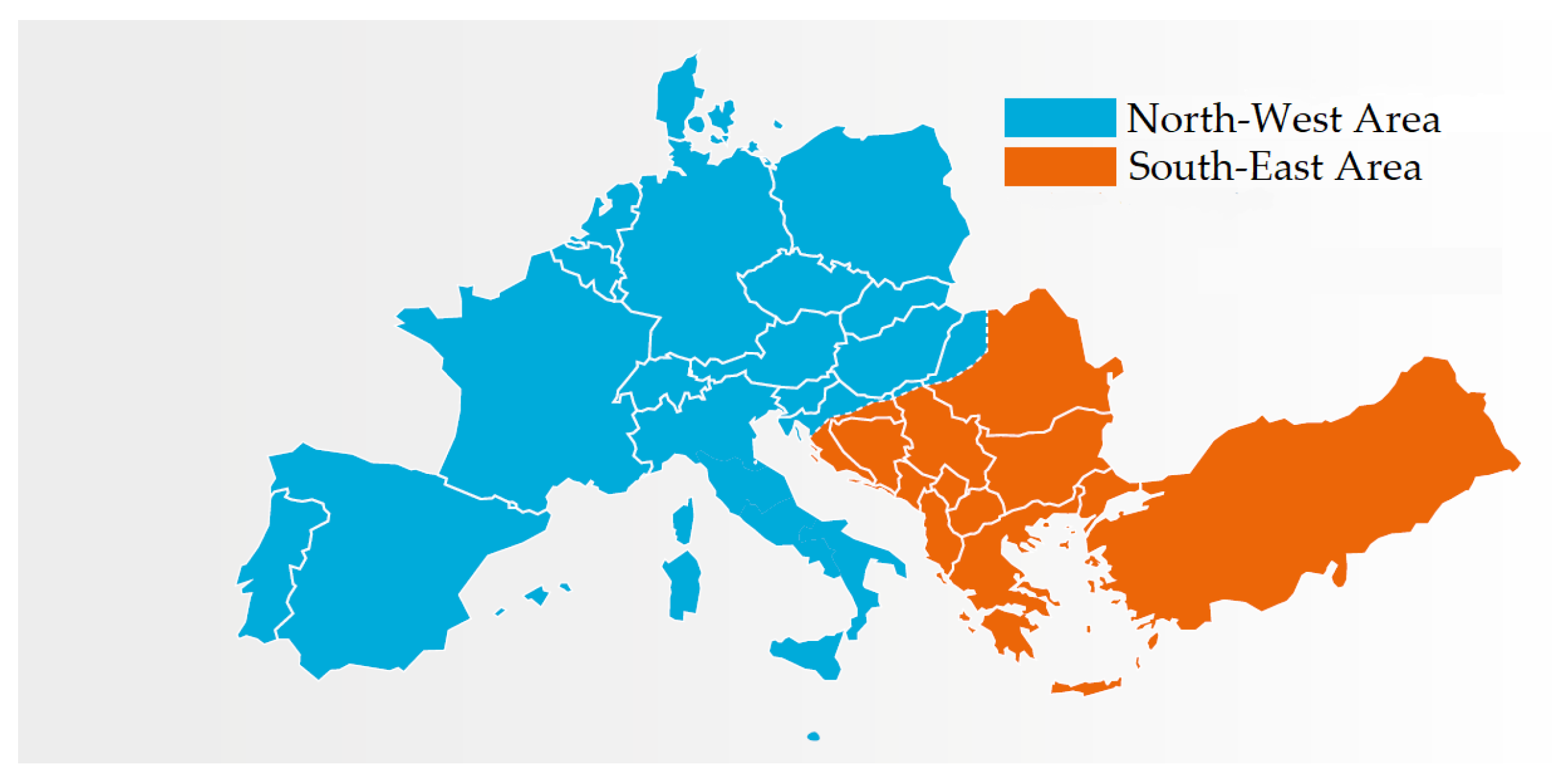
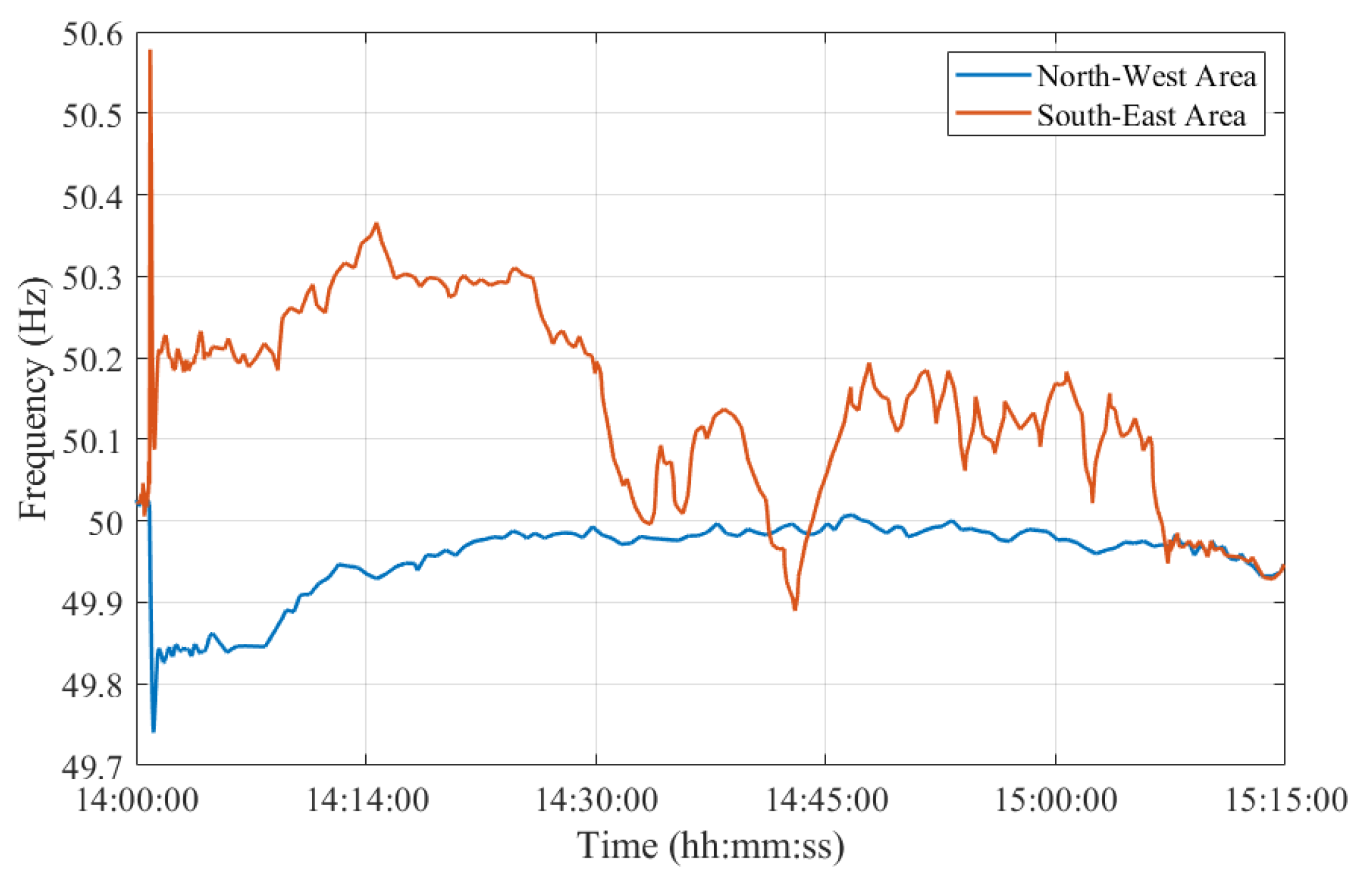


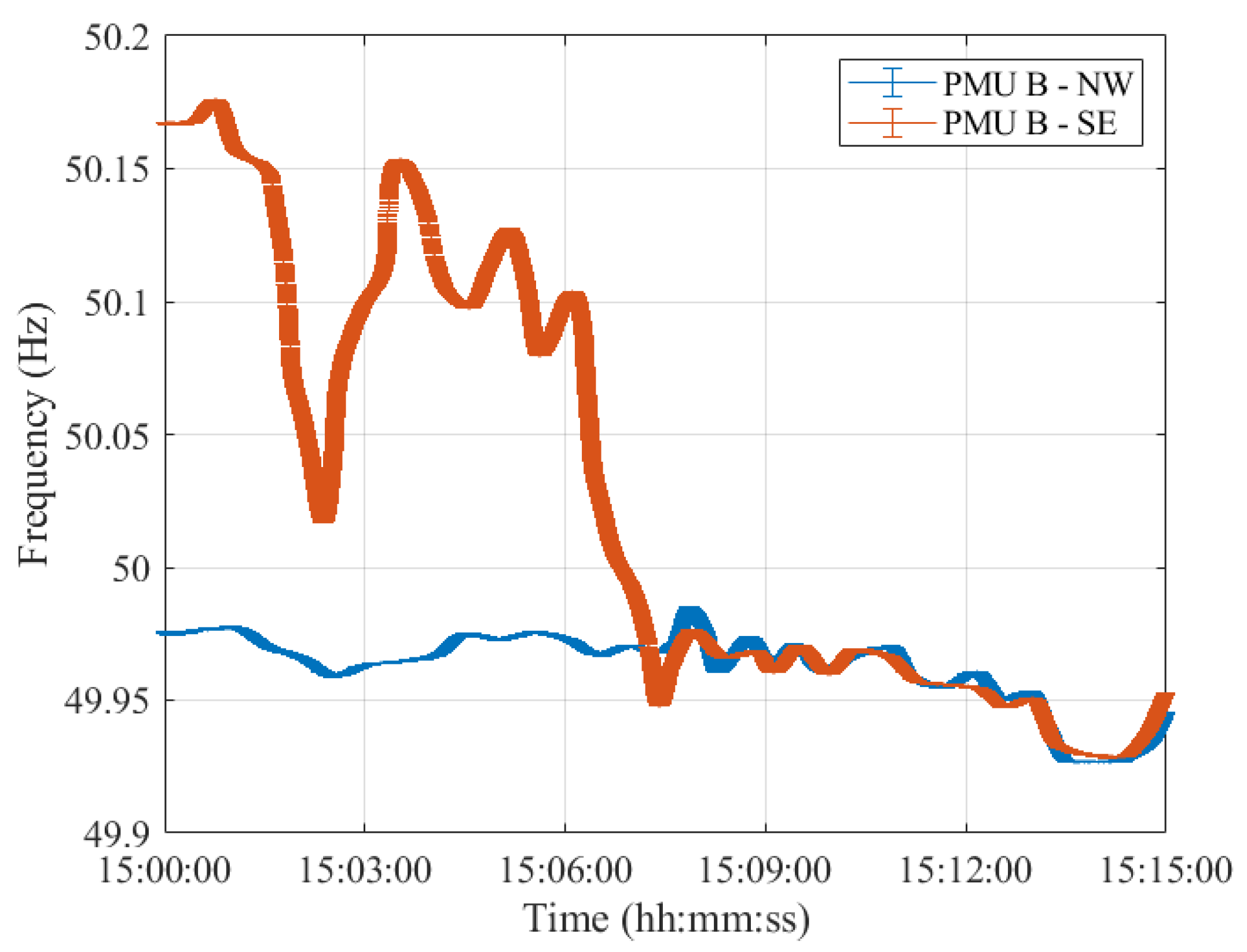


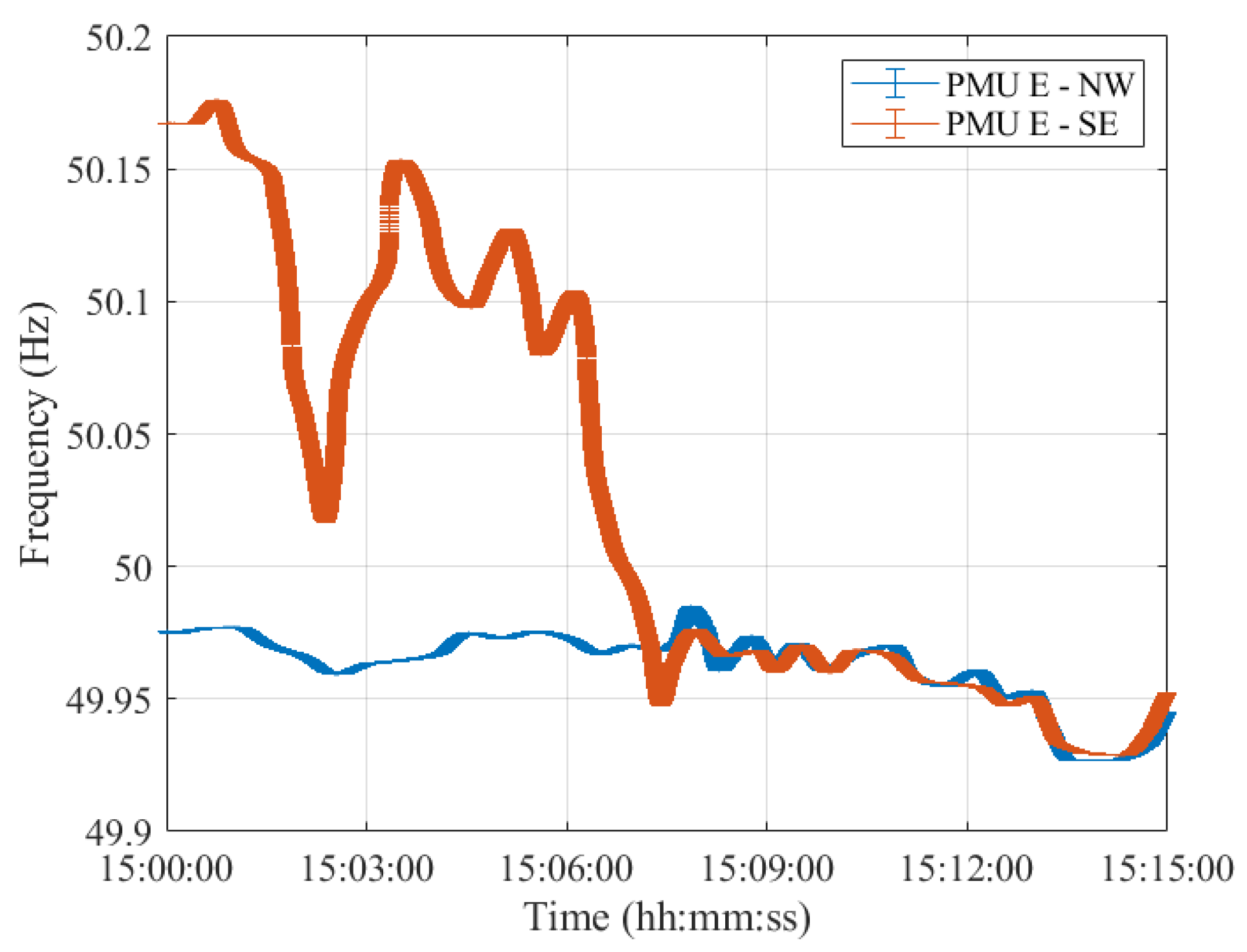


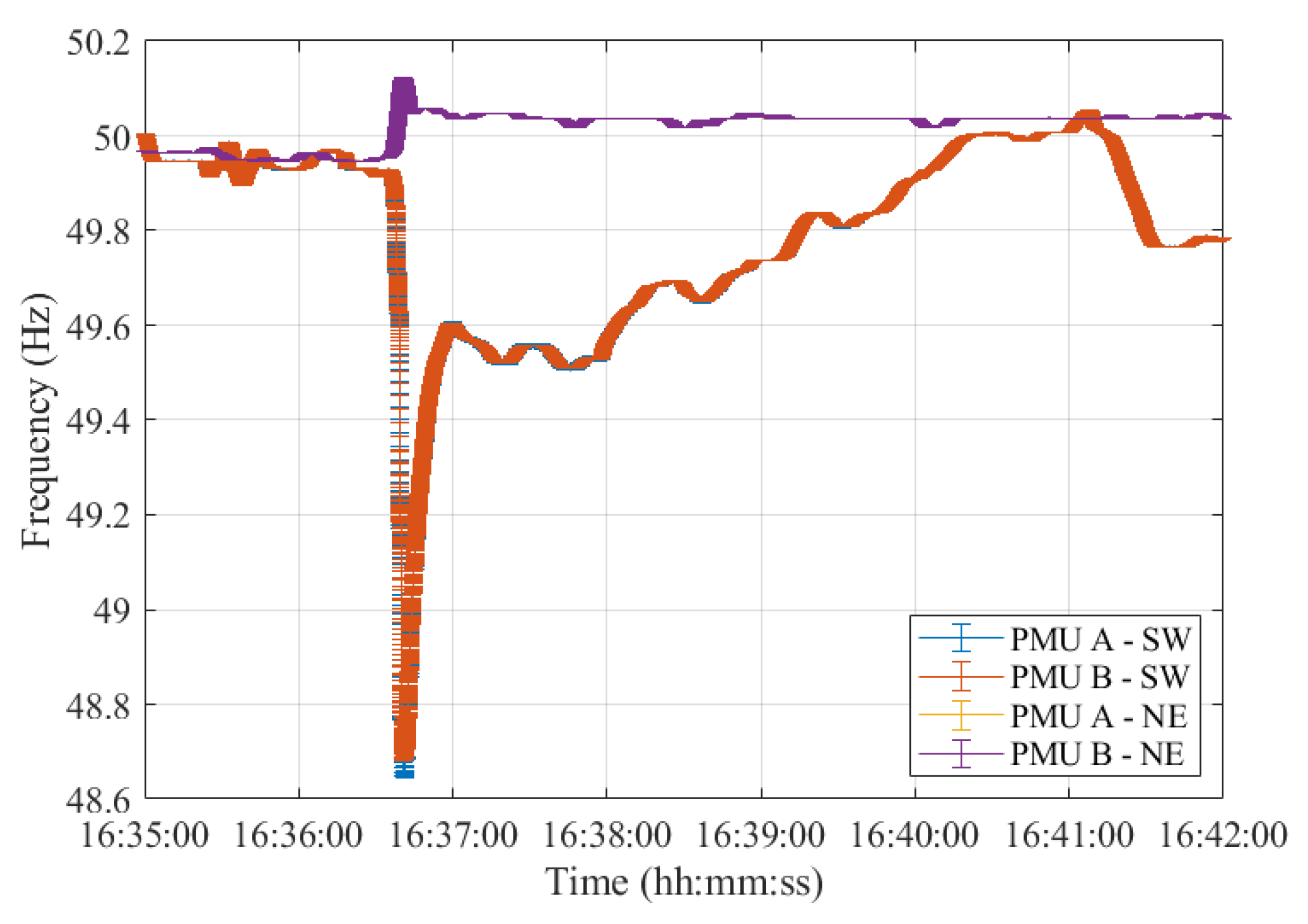


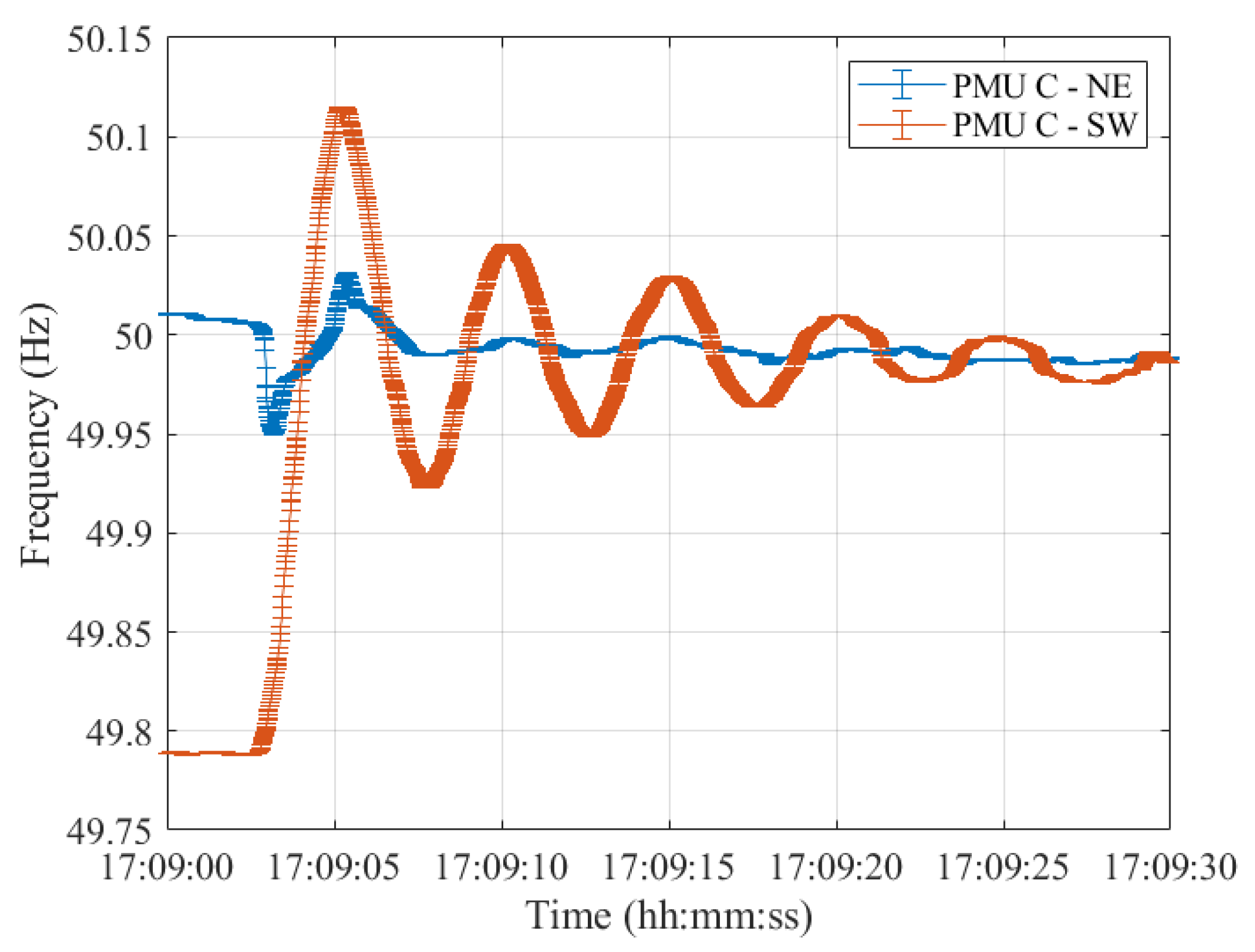
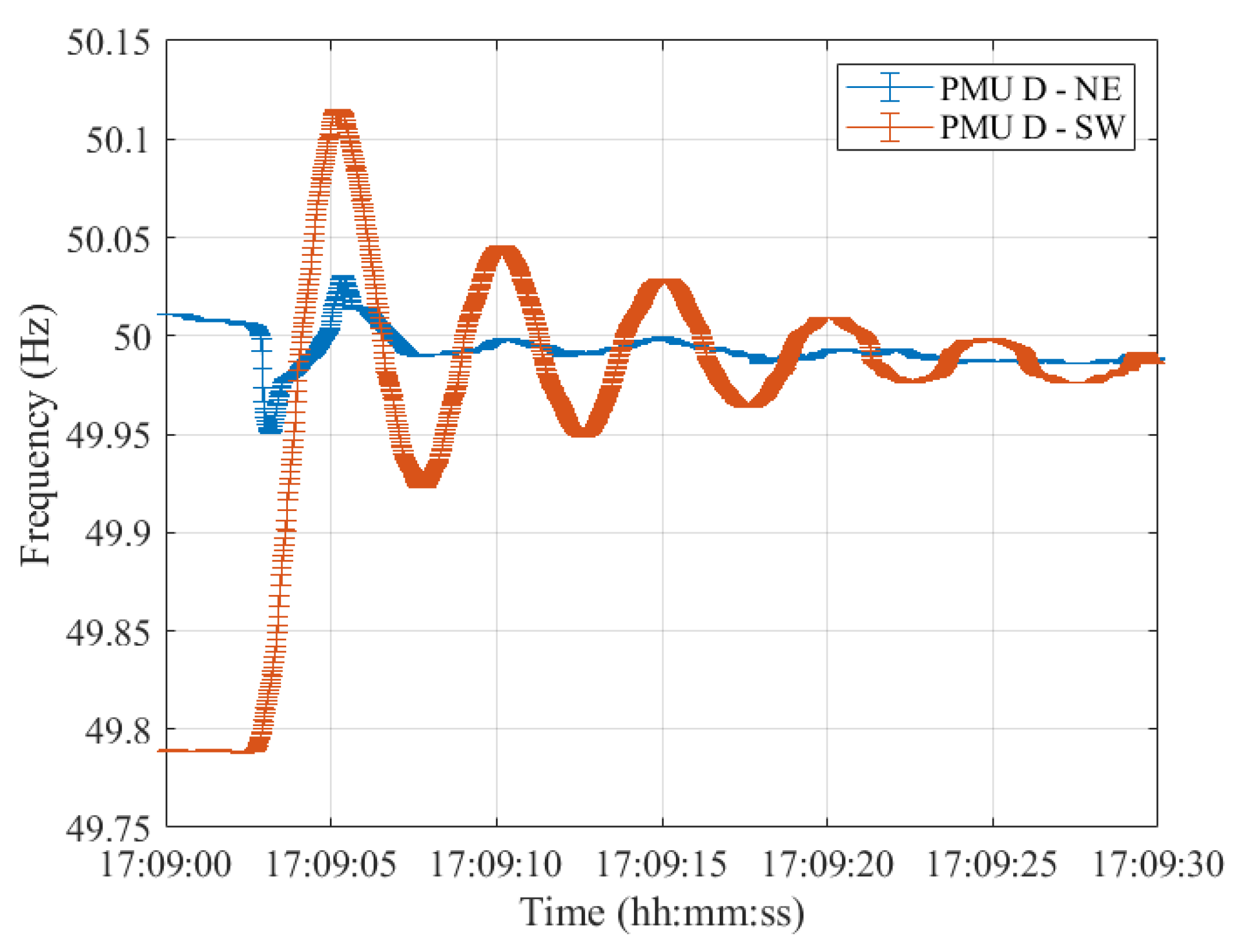

Disclaimer/Publisher’s Note: The statements, opinions and data contained in all publications are solely those of the individual author(s) and contributor(s) and not of MDPI and/or the editor(s). MDPI and/or the editor(s) disclaim responsibility for any injury to people or property resulting from any ideas, methods, instructions or products referred to in the content. |
© 2023 by the authors. Licensee MDPI, Basel, Switzerland. This article is an open access article distributed under the terms and conditions of the Creative Commons Attribution (CC BY) license (https://creativecommons.org/licenses/by/4.0/).
Share and Cite
Costa, F.; Peretto, L.; Frigo, G. Impact of Estimation Uncertainty in PMU-Based Resynchronization of Continental Europe Synchronous Areas. Sensors 2023, 23, 2705. https://doi.org/10.3390/s23052705
Costa F, Peretto L, Frigo G. Impact of Estimation Uncertainty in PMU-Based Resynchronization of Continental Europe Synchronous Areas. Sensors. 2023; 23(5):2705. https://doi.org/10.3390/s23052705
Chicago/Turabian StyleCosta, Federica, Lorenzo Peretto, and Guglielmo Frigo. 2023. "Impact of Estimation Uncertainty in PMU-Based Resynchronization of Continental Europe Synchronous Areas" Sensors 23, no. 5: 2705. https://doi.org/10.3390/s23052705
APA StyleCosta, F., Peretto, L., & Frigo, G. (2023). Impact of Estimation Uncertainty in PMU-Based Resynchronization of Continental Europe Synchronous Areas. Sensors, 23(5), 2705. https://doi.org/10.3390/s23052705







